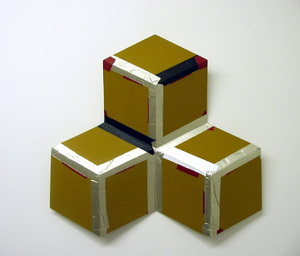This is an archive of the ArtCat Zine, 2007-2009. Please visit our new project, IDIOM.
Ivin Ballen, 50/50 at Winkelman Gallery

27 x 27 x 4 inches.
Courtesy Winkelman Gallery.
50/50
Ivin Ballen
Winkelman Gallery - 637 W. 27 St., New York NY
29 November 7008 - 5 January 2008
The more modest materials of artistic practice occasionally come under the purview of the artist and are elevated to the status of art. In the 70s, when Rauschenberg was short on materials, having just moved from New York to a small island near Florida, he looked around his studio and saw the clutter of packing supplies and other detritus. He took immediately to what was at hand, and the Cardboards, a series of works made from simple cardboard boxes, were born.
New York artist Ivin Ballen was also struck with a similar revelation: while transporting several of his earlier works across country, he looked in the back of his car and found the works, wrapped in plastic and cardboard, transformed.
Ballen set about investigating this new vision, and while his paintings are immediately reminiscent of those shocking Duchampian works of Raschenberg, they are anything but ready-made. Ballen’s process involves building a maquette from humble materials, casting them in fiberglass or resin, and painting them with trump l’oeil finish.
At first glance the effect is convincing, and without close scrutiny the objects appear to resemble so much contemporary art (see: Un-monumental at the new Museum) with their wacky assemblage construction. Upon inspection the paintings reveal elements of their process. “Tape” impresses rather than exudes, depths become protrusions, and the whole is a negative of its model. This reversal is characteristic of Ballen’s work—here the ready-made is actually the constructed—and more Étant Donnés than Fountain.
Ballen has an loving relationship with the mimetic properties of his objects but isn't content to merely copy the surfaces of his models. Grape Mine, a vaguely H-shaped work, has a perspectival painting of two crossing L beams on one of its barrel shaped protrusions. The image raises the epistemic question of which representation is closer to reality: that of the painted beams, or the sculptural elements that imitate the objects from which they are cast.
Both are an illusion, of course, but Ballen deftly suspends his paintings in the interplay between the reality of the object and its image. These works may be anything but ready-made, but they represent the ready-made by quotation. They function as a comment on the tradition of appropriation; do we really perceive the object (a urinal) or do we see the veneer (Fountain), which is art?
Further fluctuating this distinction, is the work Speakers (2-way). This sound hybrid piece produces a sort of feed-back loop, which grabs sounds from outside, themselves a sort of ready made, and projects them into the gallery space to a transformative effect. The music alters the environment of the gallery, which in turn, alters the work.
The alteration that Ballen first saw, that of his art transformed by packaging, is a reminder that what masks a thing may be more powerful than what is beneath. 50/50 is a show that examines the porous boundary between perception and artifice, producing a number of fine-distinctions along the way.
ZINE
HOME
TIPS / COMMENTS
CATEGORIES
CONTRIBUTORS
- Greg Afinogenov
- B. Blagojevic
- Adda Birnir
- Susannah Edelbaum
- Julie Fishkin
- Paddy Johnson
- Jessica Loudis
- Christopher Reiger
- Andrew Robinson
- Peter J. Russo
- Blythe Sheldon
- S.C.Squibb
- Hrag Vartanian
